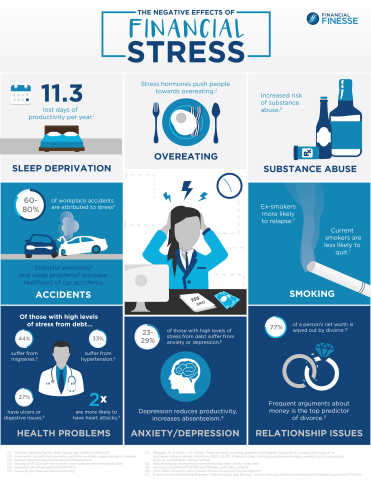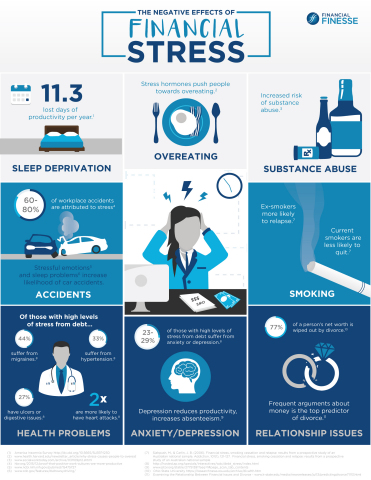EL SEGUNDO, Calif.--(BUSINESS WIRE)--U.S. employees who do not have a handle on their day-to-day expenses are more likely to experience unmanageable financial stress than those who do, according to a study released today by Financial Finesse – a financial wellness firm that serves more than 600 companies nationwide by offering financial coaching to over 2.4 million employees as a no-cost workplace benefit.
The annual Financial Stress Research study identified cash management as a primary underlying factor in determining an employee’s financial stress level. The cash management divide is wide, with employees making up two main groups: those dealing with manageable financial stress levels (some or none) and those with unmanageable levels (high or overwhelming). Employees who have manageable financial stress generally exercise good money management behaviors, with most having a strong financial foundation in place to achieve longer-term financial goals. Unmanageable stress levels, however, reflect a sense that one’s finances are out of control, and that there is little hope for turning things around. Generally these are the employees who are living paycheck to paycheck, with expenses exceeding their incomes and/or with large debt balances and no emergency savings.
|
Manageable vs. Unmanageable Financial Stress |
||||||
| MANAGEABLE | UNMANAGEABLE | |||||
| HAVE A HANDLE ON CASH FLOW | 80% | 36% | ||||
| HAVE AN EMERGENCY FUND | 59% | 16% | ||||
| PAY THEIR BILLS ON TIME | 95% | 67% | ||||
Liz Davidson, CEO and founder of Financial Finesse, says the only way to address unmanageable financial stress is to help employees get a handle on what they’re doing with their wallets every day. The firm’s Think Tank of CERTIFIED FINANCIAL PLANNER™ professionals recommends employers use Financial Finesse’s C.A.L.M. Financial Stress Reduction Model™ as a standard in their financial wellness efforts to help employees get a handle on their cash management:
C – Create a plan to manage cash flow, working with a coach if necessary
A
– Automate bill payment & saving for emergencies
L – Lower
nonessential spending and debt
M – Make progress one step at a time
The C.A.L.M.™ Model is particularly helpful for women in the workforce, says Davidson, as they are at heightened risk of unmanageable financial stress compared to men. At highest risk are women under the age of 30 who have minor children at home and make under $60,000 a year—with a whopping 54% reporting high or overwhelming financial stress.
This level of financial stress is expensive, both to employers and employees. Stress has been linked to unhealthy habits like overeating, and unmanageable levels of financial stress can lead to serious health issues. An AP-AOL Health Poll found that people experiencing high stress caused by debt are more likely to struggle with depression, anxiety and heart problems than people with low levels of stress caused by debt. They also experience more relationship issues and substance abuse problems. The direct blow to employers comes in the form of lost productivity, increased risk of on-the-job accidents and absenteeism. If this epidemic continues to grow, Davidson says companies could be facing a much bigger dilemma where financial stress is so widespread in the workforce that it will be difficult to reverse.
Fortunately, treatment for financial stress is becoming more common in the workplace. According to a report by Aon Hewitt, 89% of employers are very or moderately likely to implement or expand programs to help employees better manage their money as part of their overall benefits package. Linda Robertson, CFP®, ChFC®, CEBS, MSFS, Senior Resident Financial Planner with Financial Finesse and lead author of the report, says the greatest demand is for one-on-one financial coaching. According to Robertson, “employees who work with a financial coach are more likely than those who engage exclusively online with financial wellness programs to have a handle on their cash flow, to have an emergency fund, and to pay bills on time.” She adds: “They’re also more likely to be on track for retirement and to feel confident in how they are invested, which is a stress relief in and of itself.”
To download the report, go to https://ffinesse.box.com/v/FinStressResearchReport
About Financial Finesse
Financial Finesse provides unbiased financial guidance and education to employees through their employers, delivered as comprehensive financial wellness programs. Its education is proven to improve employees’ financial security and provides a clear return on investment for their employers in productivity, absenteeism, health care costs, and more. All programs are customized and holistic, delivered by CERTIFIED FINANCIAL PLANNER™ professionals who do not sell any financial products or manage assets. Its multi-channel education approach offers a variety of channels such as live workshops, webcasts, one-on-one financial counseling sessions and a financial helpline—reaching over 2.4 million employees at over 600 companies. www.financialfinesse.com




